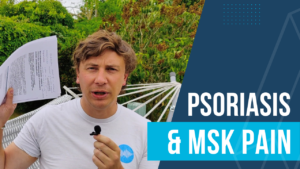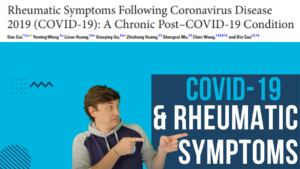Welcome back to the blog! We are catching up with the Poll that ran a few weeks ago now and I am responding to the clamour of cheers for a blog on Sjogrens Syndrome. Here it is, I hope you find it useful!
The recurrent features are back with legend of the blog and music (proper metal this week) with Alter Bridge at the bottom of the page.
Please consider heading to the shop to find more resources and supporting me to continue this hairbrained project! Or you can Buy A Coffee
You can also listen to all of my blogs as podcasts subscribe to your preferred channel HERE You can also find my podcast on Apple & Spotify & Google
As usual feedback is greatly appreciated and any further reading for me please send it my way!
PLEASE REMEMBER – THIS BLOG IS NOT A REPLACEMENT FOR CLINICAL REASONING, IF YOU ARE UNSURE GET ADVICE
Legend of the blog – This weeks legend of the blog is Mike Dare, not only is he my co-host on some of the RheumMates podcasts but he also became a father for the first time just over a week ago. An all around legend, find him on twitter @MRheumy
Sjogrens Syndrome
You may notice I don’t write a lot about connective tissue disorders, and there is a very good reason for that. They are very complicated and it is easier for me to stay in my lane and not challenge myself too much… I could ignore the calls for a blog on Sjogrens Syndrome no longer so I have spent some time on it.
Introduction
Sjogren’s Syndrome (SS) is an inflammatory connective tissue disorder characterised by affecting secretory glands such as in the mouth and the eyes. Musculoskeletal symptoms are often vague and diffuse with associated fatigue. Significantly more common in women and peak onset of 50-60.
Some US studies have shown 2-3 times higher prevalence rates in people of African-American Ethnicity.
Sometimes Sjogren’s Syndrome is a primary condition and other times it is secondary to another clinically important inflammatory condition such as Rheumatoid Arthritis (RA) or Systemic Lupus Erythematosus (SLE).
Key points
- Musculoskeletal symptoms of SS are often vague and diffuse
- It is key to ask about fatigue levels and possible causes
- Ensuring in-depth questioning about eye, mouth and vaginal secretions are a vital component of recognising a potential case
- Sjogrens syndrome is far more common in women than men (approx. 9:1 ratio)
Clinical Presentation
I am going to start with the Musculoskeletal presentation, however these are not always the predominant symptoms. A comprehensive assessment is necessary for individuals.
Musculoskeletal Manifestations
These symptoms are often vague and diffuse so it is important to ensure you are aware of the differential diagnosis when other diffuse conditions are suspected such as Fibromyalgia, Hypermobility Syndromes or other persistent pain issues/central sensitisation.
Arthralgias are very common occurring in 50-75% with a specific arthritis with synovitis in 10-30% of people with SS. These occur variably in relation to the “sicca” symptoms (discussed later) approximately 20% have their articular symptoms prior and 50% simultaneous onset. This can be complicated with the relationship with RA and SLE – luckily for the majority reading this blog, referral to Rheumatology is the approach for all the above!
Myalgias are also common reported by up to 70% of SS patients, this can be accompanied by mild diffuse weakness.
Dry Eye
Dry Eye is one of the most prominent clinical features of SS. It is the most common of the Sicca Syndrome symptoms which are broadly speaking excretionary issues. Other ocular issues can be burning, grittiness, itching, redness, photophobia and more.
People may be already using artificial tears to manage the symptoms. It is likely that they will need specialist input to determine the exact cause of the dry eyes. These symptoms are usually exacerbated by air conditioners, the wind and low humidity or activities that require concentration like watching TV or reading.
Dry Mouth
Another of the Sicca Syndrome symptoms. Oral symptoms extend beyond the simplistic dry mouth affecting eating, the teeth, mouth sores, dysphonia and more.
Initially this begins as an intermittent dry mouth but as the condition deteriorates the person will report drinking water near constantly to keep their mouth moist. Issues with unpleasant tastes, chewing and swallowing become problematic.
Vaginal Dryness
A change in vaginal dryness alongside the previously mentioned Sicca Syndrome symptoms or MSK manifestations may also be present. Women may report an increase in use of vaginal lubricants and infections can become more likely.
Fatigue
After Dry Eye and Dry Mouth, fatigue is the commonest symptom affecting 70-80% of SS patients. Its cause is unknown in SS and likely to be multifactorial.
Investigating
It may not come as a surprise after reading the first portions of this blog but this is not easy either… Antinuclear Antibodies (ANA) and Rheumatoid Factor positivity are the most prevalent in SS but seriously lack specificity. ESR is variably raised but again not reliable.
Imaging might be of use in articular manifestations, point of care ultrasound to look for synovitis for example.
Onwards Referral
Refer onwards to Rheumatology for investigations, differential diagnosis and management planning. Given the information above I would advise against prior investigations except for reasons of other clinically relevant conditions. Many Rheumatology departments have dedicated Connective Tissue Disease clinics but check the pathways locally.
Conclusion
I hope this helps MSK therapists in their recognition of Sjogrens Syndrome, I would be really interested to hear case studies and anecdotes. You can find a clinical scenario in my EBook for more reading.
Music Choice: Alter Bridge – “Open Your Eyes”
“Will they open their eyes
And realize we are one?
On and on we stand alone
Until our day has come”
Brito-Zerón P, Acar-Denizli N, Zeher M on behalf of the EULAR-SS Task Force Big Data Consortium, et alInfluence of geolocation and ethnicity on the phenotypic expression of primary Sjögren’s syndrome at diagnosis in 8310 patients: a cross-sectional study from the Big Data Sjögren Project ConsortiumAnnals of the Rheumatic Diseases 2017;76:1042-1050
Vivino FB, Bunya VY, Massaro-Giordano G, Johr CR, Giattino SL, Schorpion A, Shafer B, Peck A, Sivils K, Rasmussen A, Chiorini JA, He J, Ambrus JL Jr. Sjogren’s syndrome: An update on disease pathogenesis, clinical manifestations and treatment. Clin Immunol. 2019 Jun;203:81-121. doi: 10.1016/j.clim.2019.04.009. Epub 2019 Apr 29. PMID: 31022578.


